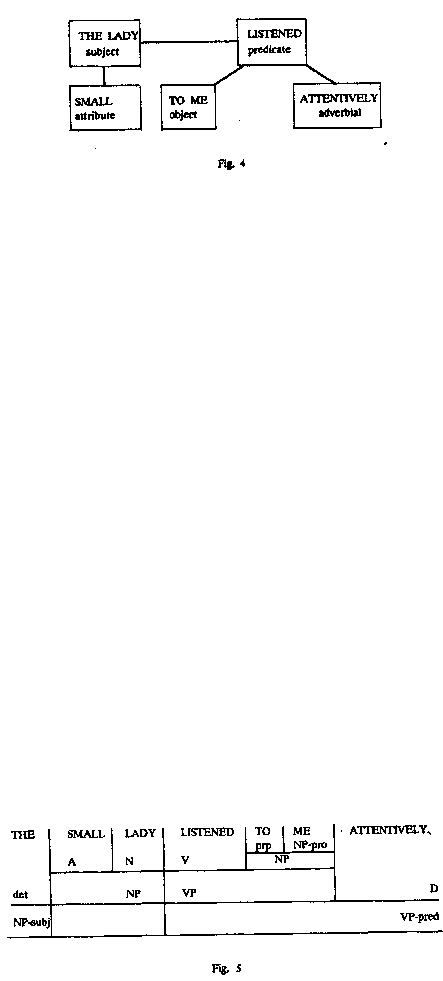
127
The scheme clearly shows the basic logical-grammatical connections of the notional constituents of the
sentence. If necessary, it can easily be supplemented with specifying linguistic information, such as indications
of lexico-grammatical features of the sentence parts the same as their syntactic sub-functions.
However, observing the given scheme carefully, we must note its one serious flaw. As a matter of fact,
while distinctly exposing the subordination ranks of the parts of the sentence, it fails to consistently present
their genuine linear order in speech.
This drawback is overcome in another scheme of analysis called the "model of immediate constituents"
(contractedly, the "IC-model").
The model of immediate constituents is based on the group-parsing of the sentence which has been
developed by traditional grammar together with the sentence-part parsing scheme. It consists in dividing the
whole of the sentence into two groups: that of the subject and that of the predicate, which, in their turn, are
divided into their sub-group constituents according to the successive subordi-native order of the latter. Profiting
by this type of analysis, the IC-model explicitly exposes the binary hierarchical principle of subordi-native
connections, showing the whole structure of the sentence as made up by binary immediate constituents. As for
equipotent (coordinative) connections, these are, naturally, non-binary, but, being of a more primitive character
than subordinative connections, they are included in the analysis as possible inner subdivisions of subordinative
connections.
Thus, structured by the IC-model, the cited sentence at the upper level of analysis is looked upon as a united
whole (the accepted symbol S); at the next lower level it is divided into two maximal constituents - the subject
noun-phrase (NP-subj) and the predicate verb-phrase (VP-pred); at the next lower level the subject noun-phrase
is divided into the determiner (det) and the rest of the phrase to which it semantically refers (NP), while the
predicate noun-phrase is divided into the adverbial (DP, in this case simply D) and the rest of the verb-phrase to
which it semantically refers; the next level stages of analysis include the division of the first noun-phrase into
its adjective-attribute constituent (AP, in this case A) and the noun constituent (N), and correspondingly, the
division of the verb-phrase into its verb constituent (V or Vf-finite verb) and object noun-phrase constituent
(NP-obj), the latter being, finally, divided into the preposition constituent (prp) and noun constituent (N). As we
see, the process of syntactic IC-analysis continues until the word-level of the sentence is reached, the words
being looked upon as the "ultimate" constituents of the sentence.
The described model of immediate constituents has two basic versions. The first is known as the "analytical
IC-diagram", the second, as the "IC-derivation tree". The analytical IC-diagram commonly shows the groupings
of sentence constituents by means of vertical and horizontal lines (see Fig. 5). The IC-derivation tree shows the
groupings of sentence constituents by means of branching nodes: the nodes symbolize phrase-categories as
unities, while the branches mark their division into constituents of the corresponding sub-categorial standings
(see Fig. 6).

